BARRY THOMPSON LOOKS AT THE EARLY YEARS OF THE 60S AND 70S WHEN FIBREGLASS BOAT BUILDING IN NEW ZEALAND WAS IN ITS INFANCY, AND REFLECTS ON SOME OF THE PIONEERS WHO HAVE MADE THE INDUSTRY WHAT IT IS TODAY.
Firstly, what is fibreglass? Glass-reinforced plastic (GRP), also known as glass fibre-reinforced plastic, is a fibre reinforced polymer made of a plastic matrix reinforced by fine fibres made of glass. It is also known simply by the name of the reinforcing fibres themselves: fibreglass.

GRP was developed in the UK during the Second World War as a replacement for the moulded plywood used in aircraft radomes (GRP being transparent to microwaves). There is a common mis-perception that fibreglass boats have existed only from the 1950s, although it is true that serious production for the commercial market started about then. The fiberglass boat revolution actually began when polyester resin, which had been invented in 1935, was used to build the first known fibreglass boat, a dinghy built in the USA in 1942.
The resin required reinforcement, and builders experimented with various materials (even palm fronds) before arriving at glass fibres.
Other ‘plastic’ boats followed, an example appearing at a US boat show in 1947. Altogether, it’s likely that thousands of fibreglass boats, some quite small, existed by the late 1940s. By the mid 1950s, the smells in local boat shops were changing. The tang of wood shavings was giving away to resins and rovings and the writing was on the wall. Although many of the leading trailer boat builders had a love of building timber boats, they knew that fibreglass was becoming the boat building material of the future. Unless they changed, their company would be left behind.
In New Zealand, the first to use fibreglass in a commercial boat building application was probably Christchurch boat builder Arnold France in 1955 and later Gisborne based Condor Craft. However, it was Fi-Glass that turned the industry on its head and took volume boat production to a new level.
Fi-Glass founder Frank Simpson remembers well those early days of fibreglass boat building. “In the beginning, I was against building boats because Arnold France, who built the first fibreglass production boats in New Zealand under the name France Craft, appeared to have the market tied up. They were a bit rough, but solidly built and I didn’t think there was an opening for another fibreglass boat builder in New Zealand.”
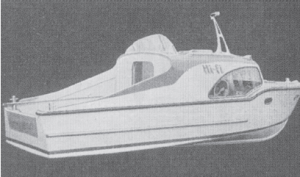
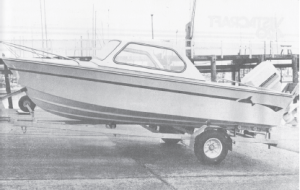
In 1963 Vistacraft boats, built by Hewitt Industries, offered two trailerable models, the 3.8m Spraymate and the 5.18m Venture family cabin cruiser. By the mid 70s they produced three models, the Vistacraft 420, Vistacraft 480 and Vistacraft 520, all of which were available in runabout, cabin or cabin convertible models.
B&R Moulders (later Fibreglass Moulders) had young up and coming designer Rex Henry design a 4.87m runabout they called the Seabird in 1964, which was the start of a hugely successful boat building name, Fleetline Boats. Within 10 years the company was one of the driving forces of the industry with its extremely popular Fleetline Sapphire 4.5, selling in excess of 2500 units.
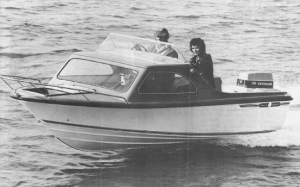
In 1963 Peter Morgan (now our Technical Editor), then a student at The University of Auckland School of Engineering, was the first in the country to run laboratory tests on composite sandwich panels suitable for boat construction. He settled on a strip cedar core with epoxy/GRPwovenrovingsbothsidesandbegan construction of Aurora, a 20ft deep V hull of his own design that went on to become the Clipper 20, and in 1972 the Morgan 6.3. Aurora was New Zealand’s first composite sandwich boat.
By the mid 1970s the largest fibreglass boat builders in the country were CWF Hamilton MarineandFi-GlassProducts, bothChristchurch based. Fi-Glass had eight basic hulls from which were built 12 different models. CWF Hamilton had nine models, all obviously powered by inboards and jets. At a time when Sea Nymph offered six boats in its line-up, Plylite had five, Haines Hunter four and Bonito just two, Fi-Glass and CWF Hamilton were right out there on their own.
Reflex Products was established in Christchurch in 1974 and while it offered an extensive range of its own designs, in 1987 Reflex teamed up with John Haines to build “Haines Signature” boats under contract. By 1990 Reflex products had secured the full manufacturing and distribution rights for “Haines Signature” boats in New Zealand.
By 1976 there were just on 100 different models available from 30 manufacturers, from 3.5m to 7.5m. Brands such as Andrews, Apollo, Artek, Bonito, Barracouda, Campbell Craft, Delta, Glasskraft, Kingfisher and Marlborough were part of a buoyant and expanding market. Today, none of those brands exist. The only brands from that era that have maintained a presence are Cresta Craft, Fi-Glass, Haines Hunter, Hamilton Jet, Morgan and Smuggler.
Interestingly it was back in the early 1970s that Kiwis were introduced to the first American imports, with a selection of five Glastrons, including the “James Bond” inspired GT150, offered by Hamilton based Avonex Industries.
Simpson the Pioneer
When Frank Simpson built his first all-fibreglass production trailer boat in 1962 under the Fi- Glass banner, he changed the way we looked at our family boating. It didn’t happen overnight, but it did happen! Thousands of boats later, Fi-Glass, now under the direction of Frank Simpson’s son Griff, is still producing fibreglass boats and is still one of the leading brands in the country.
Fi-Glass Products Ltd was formed in 1958 to take advantage of new fibreglass technology in the manufacture of washtubs and shower trays. However, with the expertise gained from these humble beginnings came the first Fi-Glass boat, the 3.5m Fisherman, designed by Brian Wall. It created a great deal of interest from the start, and the company grew from there.
Early Fi-Glass models such as the Regent and Firecrest were sold with plywood decks, or as hulls-only for the purchaser to finish.
By 1964 these hulls had developed to a complete boat with fibreglass deck. After exhibition at the Auckland Boat Show, orders quickly came and production was stepped up to six boats per week. When production ceased in 1968, 364 Firecrests had been built.
In 1968 Fi-Glass released the Fireball, a boat that was so successful that the company rapidly expanded its manufacturing facilities to try and meet the demand. Over 2000 were built in various forms including a jet boat version.
With better design and production facilities in place, a string of additional Fi-Glass models were produced, such as the Firestar, the Lightning, the Regent and the very sleek Sidewinder ski/ race boat. All early Fi-Glass cabin boats were basically a runabout with the hard top unit, and windows bolted on.
In 1972 the 5.8m Viscount was introduced. The Viscount was a significant step forward for the company and took advantage of the larger outboards that were by then being produced. At 5.8m it was one of the largest production trailer boats available and certainly the most popular.
Ex Timaru Fi-Glass dealer Barry Ford remembers well the Viscount. “At one point we were delivering one new Viscount a day and we just couldn’t get enough product from the factory to satisfy the demand from our customers”.
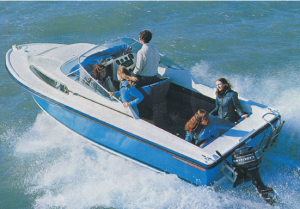
Well over 1500 of the Viscounts in various models were produced, with the last Viscount built in the late ’90s. The 4.3m Scamp (over 1000 produced) and 7.0m Baron (350 produced) appeared in 1975 along with the next successful production model, the Dominator. Today, over 1500 Dominators have been sold in New Zealand.
In 1977 the Warrior was released and this has proven to be one of the most successful cabin boats ever by Fi-Glass. Well over 1200 units have been sold.
In 1977 Fi-Glass had a twelve-model line-up, from the 4.26m open Ski Angler to the 7.0m Baron cabin boat. Today, the line-up comprises nine models from the 5.0m Firecrest to the 6.40m Warrior.
The Sands of Time
Another builder who very early on saw the future in fibreglass was Sandy Sands, whose company Seacraft had been around already since 1946 and had produced thousands of timber boats from mainly kahikatea and kauri. In the mid 1950’s Sandy went to the USA to learn more about this ‘new’ boat building medium,fibreglass, from one of the earliest exponents, John Norek of Costa Mesa, California. However, it wasn’t until 1967 that the Seacraft factory in Ellerslie was changed over to a fibreglass production boat operation with a temperature control glass shop.
Names such as Costa Mesa, Sierra and Valencia became part of the New Zealand boating vocabulary. Production of the boats went well into the hundreds and all were designed by Sandy, who could often be seen on the water testing his latest creations with son Lionel, who now heads this iconic family company.
“Safe, wholesome family boats for the average bloke”, said Sandy. “If you are into pleasure boating you don’t want to be thumping about at 60 mph, that’s too fast”, he used to say.
In 1979 the 20% boat tax was imposed by the Muldoon regime and it shattered the boat building industry and there were many casualties as a result. Brands disappeared almost overnight as orders dried up.
As the industry started to come out of the slump, Seacraft directors decided to combine forces with Les Miller of Miller Moyes to form Miller Moyes Seacraft. They obtained the Haines Hunter moulds after Fleetline Boats closed down. The transition quickly established the company as a leader in the industry, a position it still holds today.
The Haines Hunter became the first non-Sands design Seacraft produced and from it was born the incredibly popular V198, of which over 700 were built. In fact by 1982 the company had retired all the Seacraft moulds and changed over completely to the deeper vee Haines Hunters. Today, the association with Haines Hunter is in name only, as all the designs are now by Lionel Sands.
Lionel effectively took over the helm in 1976, although Sandy still insisted on going to work every day, making a few oars and giving the apprentices a bit of cheek. Sadly, he passed way in 1990, doing what he had always done, shaping an oar over his old wooden workbench.
Buccaneer
Another of the start-ups in the 1970s was Buccaneer Pleasure Boats, which is one of the few that is still around today. Buccaneer was established in 1976 by Gerry & Jenny Gerrand. A boat builder by trade, Gerry had spent the previous 2 1/2 years making plugs and a mould for his first release, the Buccaneer 470, in January 1977. This proved to be an immediate success and over 500 were eventually built. The first boats were sold by Bill Hamill of Hamill’s Marine in Rotorua and Roger Arkell of Roger’s Boat Shop in Auckland. Interestingly Roger’s Boat Shop is still a Buccaneer dealer, 35 years later.
This was soon followed by the Buccaneer 5.6 a few years later and the model range continued to grow from there. By 1989 this had increased with the smaller 450 and the mid range 510, in both sport and cabin versions.
With a policy of continually releasing new models virtually every season, the Buccaneer range quickly grew and improved. Older models were retired, revamped ones released and totally new designs appeared every year.
Of significance was the Billfisher series that was designed to take the American Bayliner Trophy boats head-on and the 635 DC, a centre console that also provided all the ‘kiwi’ requirements for fishing and family boating.
By far the most popular model was the Buccaneer 605 that in the late ’90s was being built at a rate of up to two a week and today there are over 1800 on the water.
While the first boats were built in a farm shed on the family farm in Taupiri, a few kilometers north of Hamilton, in 1981 the company moved to larger premises in Hamilton. It wasn’t long before the factory needed to move again to an even bigger factory, also close by in Hamilton.
The first year’s production was eight boats and by 1981 the factory production was 46 boats in six months. To date 5239 Buccaneers have been built, with the best year being 2005, when 320 boats were produced. Currently, production is just over 100 boats annually from 44 production weeks.
Clipper Luxury
Certainly the most luxurious and outstanding boat in its class, the Clipper 24 was the most expensive trailer boat on the market and epitomised the elite end of trailer boating.
The Tony Mason designed Clipper 24 was a true weekender, one of the first, and the layout was sumptuous by the standards of the day. In 1977 a Clipper 23 with a sterndrive engine package would set you back around $30,000. In that same year a Cresta Craft V19, Fi-Glass Viscount or Morgan 6.3 could be put on the water fully spec’d for around $13,000.
When first released in 1963 the hulls were all timber and ply and it wasn’t until 1967 that the first ‘glass’ Clipper was introduced.
The Clipper was in a class of its own and it stayed there for many years until the advent of the larger GRP cruisers such as the first of the Marklines. When the last of the Clipper 24s was built by Mason Marine in Auckland in 1980, there were over 100 on the water.
Condor Craft Demise
Gisborne based Condor Craft was one of the earliest companies to embrace fibreglass construction. In the early 1970s the 4.1m Condor Craft Skipjack was a huge seller. The initial V132 Skipjack was replaced in 1976 with the 136 Skipjack as a general purpose runabout. Also popular with the skiing fraternity was the 4.3m Stiletto, and the 4.8m Dolphin found favour with fishermen and those looking for a small family cruiser.
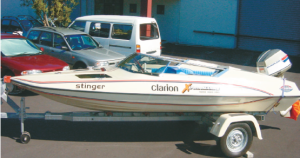
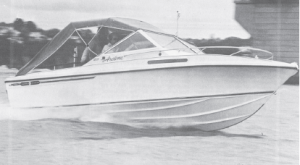
The release in the mid 1970s of the Blue Pointer, a 6m cabin cruiser, saw a whole new direction for Condor Craft with a stylish offshore boat suitable for the new breed of V6 outboards or petrol sterndrives. However, the company was one of the builders that never came out of the crippling boat tax period and faded from the market.
Plylite Popular
Unquestionably, when Plylite Marine was at its height, it was the biggest trailer boat builder in the country. However, that was when “wood ruled” and although the company started slowly into the GRP market with wooden hulls and fibreglass tops, in 1970 it entered the fibreglass market proper.
Building Bertram, Caribbean and Pride boats under licence to International Marine of Australia, Plylite fast became a driving force in fibreglass trailer boats. The company’s products included the Fisherman 15, Comaro 153, Blue Water 165 and Reefrunner 20. Similar and often confused with the Fi-Glass Sidewinder was the Plylite Panther, a sports runabout that gained huge popularity in the skiing and racing fraternity.
After being purchased by a Nelson-based entrepreneur, Plylite moved from its factory in Paraparaumu to Nelson where it continued to build boats until the early 1980s when the remaining moulds were purchased by Reflex Products in Christchurch and sold under the Reflex name.
Sea Nymph Success
In 1962 Marine Plastics released the 3.8m Sea Nymph, the boat that started this long enduring brand. Within two years the company had built 135 boats. This was later followed by the V13 and the V17 in 1966 and the V16 in 1968. By the early 1970s Auckland based Sea Nymph boats was one of the key players in the market and its range was extensive. Kiwis were brought up on the V13 and the V16 and later the V146 which was produced to fill the gap between the other two.
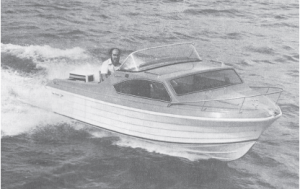
A V13 sold for $1420 in the cabin convertible form, a style that was very popular back then. For your money you got a three-sided cabin boat with a soft top and front seats like a runabout. By the mid 70s Sea Nymph realised it needed to go a little more upmarket and did a deal with the Australian builder of Savage Boats to reproduce them locally. Overnight the brand increased its options dramatically, with new models such as the Ranger, Pacific, Avenger and Electra. However, by far the most popular was the Commander 18, a 5.5m cabin boat available in either sterndrive or outboard mode.
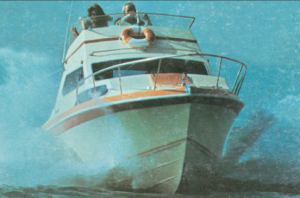
Sea Nymph then added some of its own designs such as the Escort, Wasp and Hornet and in 1976 the Sea Nymph Sovereign 24. At 7.2m it was one of the larger flybridge trailer boats, although it still retained a narrow 2.44m beam.
In the early 1980s, Sea Nymph was struggling to come out of the crippling boat tax, but in 1984 Sea Nymph, then headed by Kim McDell and Peter Gribble, pulled a master stroke.
Again the company looked to Australia and this time a deal for building and distribution rights was signed with Cruise Craft. Overnight Sea Nymph relaunched a full range of boats, amongst them the 5.67m Hustler. This was the first bowrider to gain national acceptance in New Zealand and was a mainstay of Sea Nymph sales for many years.
In 1987 Questar bought Sea Nymph and Markline and within a short time the whole business collapsed financially. The moulds were sold and the Sea Nymph name was retained and in 1991 the Hustler was re-released as the Hustler 6.04m, with a portofino stern, new deck and windscreen. The boats are no longer built in New Zealand and the moulds are now in China.
Bonito Prestige
Another of the brands that was always considered as prestigious was Bonito, founded by Wilfrid Hoelen, who had earlier founded Marine Plastics, and had come up with the iconic brand name Sea Nymph. Hoelen started Bonito in 1974 and soon the production line-up comprised three models, the ever popular Bonito 16 in both runabout and cabin versions, and the Bonito 20 cabin boat.
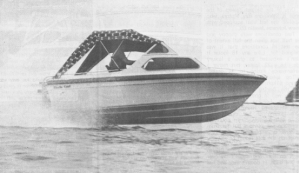
By the late 1970s a flybridge option was added to the Bonito 20 and a few years later the Bonito 186 joined the range.
While Bonito boats were always seen as being very up-market, they were surprisingly no more expensive than most of their competitors. In 1977 a Bonito 16 Cabin, boat only, sold for $3150, whereas a Cresta Craft V15.5 was $3378 and a Fi-Glass Dominator, $3047. A fully rigged Bonito 16 with a Johnson 85 and single axle trailer retailed for around $7000.
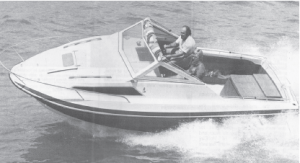
The first Bonito 16, designed by Jack Tapp, was released in 1972 and within 19 months over 230 had been sold. The last boat under the Bonito name was built in 2010. Since then, the moulds have been purchased by Smuggler Marine and the boats have been re-tooled and re-badged as Smugglers.
Markline Express
In the late 1970s, Marksply Boats was struggling to stay in the marine industry with a competitive range of boats. However all that changed when businessman Martin Jones purchased the company and changed the name to Markline.
Markline went on to become New Zealand’s largest production boat builder of large cruisers and launches and although eventually stepping away from the trailer boat market, it did start in the small boat arena. One of the early boats was the Markline 776 Express Cruiser that had the same hull as the original Marksply 22. With a $45,000 drive away price tag in 1980, it was aimed at the top echelon of the trailer boat market.
The 776 was very popular in Australia, with at least half of the boats produced going across the Tasman. The last 776 Express Cruiser was built in 1985 and over 60 were built. In 1985 the name was changed to the Markline 800 and this coincided with a major styling change.
Steady Steadecraft
A name that was very much part of the early trailer boat scene was Steadecraft. Keith Eade started the company with just three models of his own design, the Steadecraft 14 in both runabout and cabin convertible styles, and the Steadecraft 16, a full cabin model. Eade was an active powerboat racer, so it wasn’t unusual to see either model cut down and fitted with custom decks, blasting around the race circuits of the North Island.
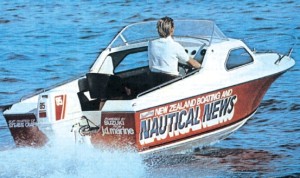
In 1975 Steadecraft released the V156, which proved to be one of the most popular boats of its size right throughout the late 70s. Steadecraft stopped manufacturing the original V156 around 1991 and reintroduced a revamped model shortly after.
In later years the moulds went through a succession of owners and today Steadecraft boats are no longer built in New Zealand.
New Arrivals
Since those early years of the 60s and 70s there have been many new arrivals on the scene and some have maintained a dominant market share for a number of years. Brands such as Seaforce (1986), Tristram (1987), Rayglass (1988), CSB Huntsman (1992), Challenger (1994) and Atomix (2004) are all still very much part of the trailer boat fraternity.
Tristram, Rayglass and CSB Huntsman have in particular risen to major national dominance and along with Fi Glass, Haines Hunter and Buccaneer are part of the very select group of local builders that arguably today manufacture over 75% of the GRP trailer boats in the country.




